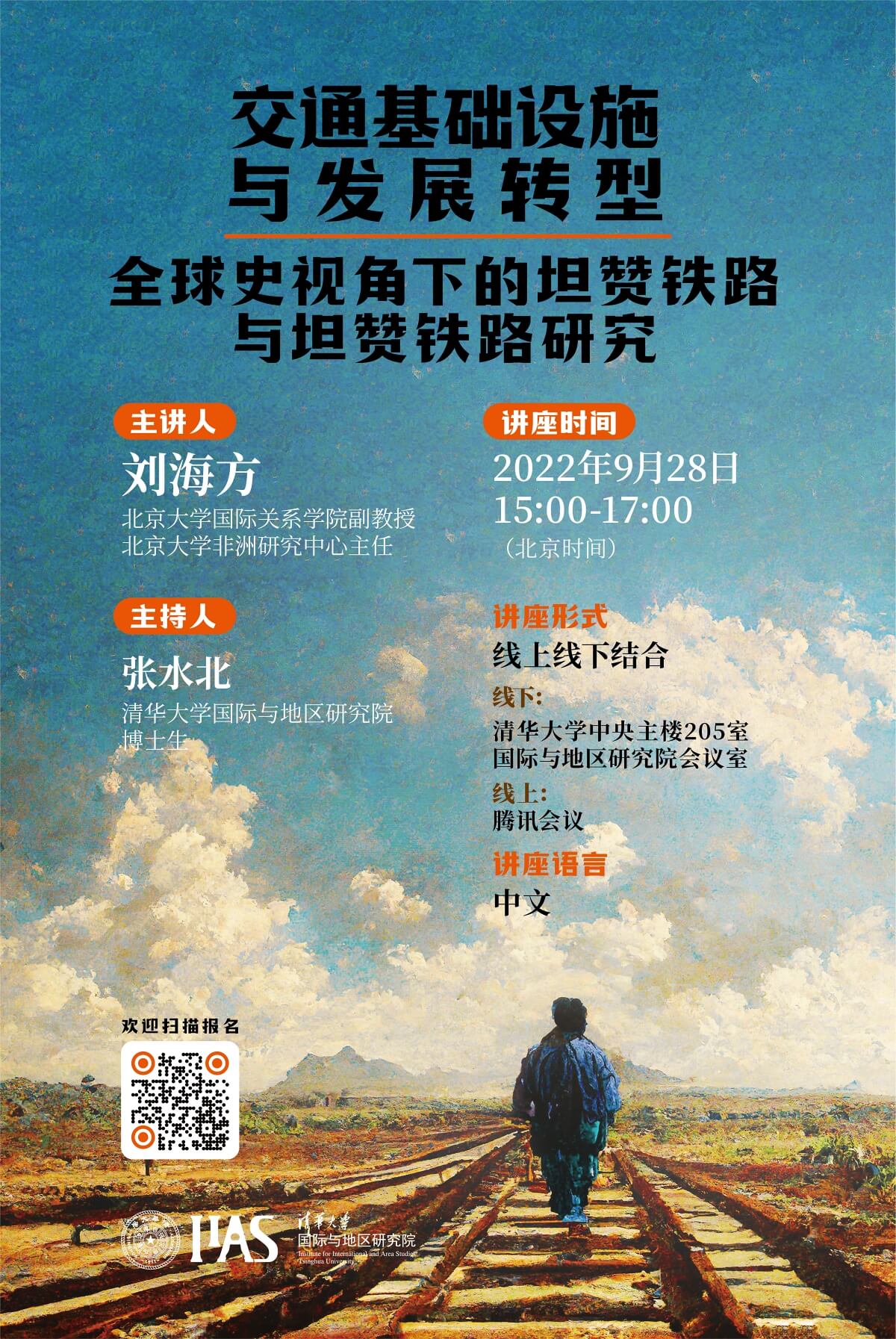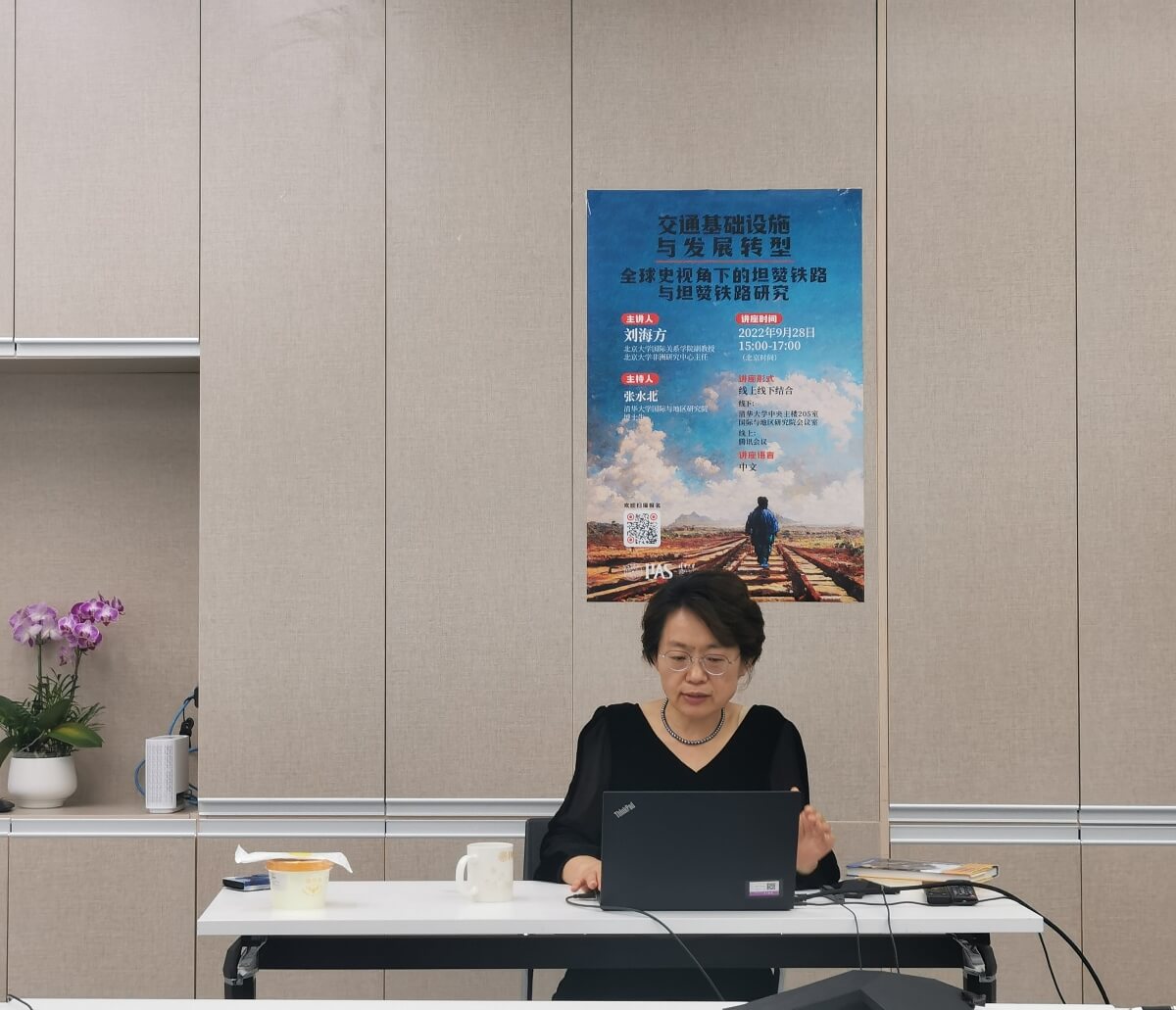
On the afternoon of September 28, 2022, the Sub-Saharan Africa Group of the Institute for International and Area Studies (IIAS), Tsinghua University held its second lecture for the 2022-2023 fall semester at Room 205, Central Main Building on the campus. The lecture was titled “Transportation Infrastructure, Development and Transition – The Tanzam Railway and Its Studies from the Perspective of Global History.” The speaker was Liu Haifang, Associate Professor of the School of International Studies and director of the Center for African Studies, Peking University, and the host Zhang Shuibei, a PhD student of the IIAS. The lecture was attended, in person or online, by IIAS faculty members and doctoral students, scholars and students from outside the Institute at home and abroad as well as people interested in the topic.
Ms. Liu began by sharing some background information of the lecture, the doubts of international peers had on the spirit of the Tanzania-Zambia Railway (also known as Tanzam Railway), and her studies about and stories with the Tanzam Railway in the past 20 years. She noted that the lecture was relevant as at home and abroad people had been discussing how to revive the Railway and what its prospects were. Then she shared her feelings about the Railway and what she saw and heard in Tanzania. She noted that China had always actively assisted Tanzania, but failed to tell the “technical assistance” story well at that time with only limited publicity efforts in terms of both intensity and coverage. Based on this, Ms. Liu shared her thoughts on China’s interaction with Africa. Chinese companies, she said, should gradually get rid of the aura of “mystique” and become “narrators.” The West used to generally believe that the Tanzam Railway had only political value but no economic value, which Liu Haifang refuted, citing a World Bank report and the Anglo-Canadian report on the Railway. She argued that the Tanzam Railway was profitable under special conditions. China began to participate in the railway administration in 1983, and the utilization of West German locomotives ushered the Tanzam Railway into a decade of profits. But since the 1990s, the Railway has seen its traffic volume fall due to regime changes in South Africa and the privatization in Zambia. Liu moved on to discuss the reasons why China’s assistance failed to achieve the desired effect, and believed the Tanzanian government’s failure to make effective use of aid programs is one of the major reasons, citing the works by Ai Ping and American scholars.
Speaking of the Tanzam Railway’s contribution, Dr. Liu said that, citing Prof. Jamie Monson’s research, it was more than a railway; what’s more important was that it rebuilt self-confidence for Tanzania, then a newly-independent country. Then, Liu raised two questions: how to evaluate the Tanzam Railway and where it would head to. She explained the research direction concerning the Railway from three different perspectives: its relationship with Nature, with man, and with geopolitics. Based on the above discussion, she discussed the role of railways, pointing out that railways can reshape the temporal and spatial relationships, demonstrate a country’s strengths and ability to mobilize, centralize and allocate resources, and significantly change the balance between sea power and land power. In addition, railways are crucial to the relationship between wealth, power and territory.
She proposed that we needed to understand the Chinese workers involved in railway construction at that time when re-evaluating and re-understanding the Tanzam Railway. It was thanks to them that the Railway project was such a great success. From this perspective, we also need to further understand the role the Chinese leadership and the first-generation leadership of the newly-independent Tanzania in this project. Their time is gone, but their efforts to build the Tanzam Railway, rebuild national self-confidence and challenge an unjust international order must not be ignored. Next, Liu explained why the Tanzam Railway was a “people’s railway”: first, it changed local economic landscape; second, it consolidated and extended local people’s identity with the railway, which was conducive to the shaping of national identity in Tanzania. At the same time, the Tanzam Railway has made great contribution to the “going global” of Chinese companies. The first Chinese companies to do business overseas had more or less to do with it. Hence, when evaluating the contribution of infrastructure, we should adopt both the African perspective and the Chinese perspective, that is, study its contribution to the economic development of each side and to their bilateral relations.
At a time when neoliberalism prevailed and the Western aid arrived, the Tanzam Railway was to some degree influenced by Western demands for “privatization.” The Railway authority experienced massive attrition and “market-based” changes (i.e. the closure of many small and medium-sized stations), following which the ten donor countries pushed for transformation with a “liberalization” plan. So far, China’s assistance, in the form of economic and technical cooperation and interest-free loans, has persisted on the whole. But there are still controversies over China’s assistance and the Railway’s future. Liu suggested that in assessing the Railway’s value and significance, we should not only see its political contribution in the early stage, but also strengthen the study of its practical contribution to economic development, to support our judgment. She also noted the substantial differences between the Tanzam Railway spirit and the West’s global expansion, and we should realize that “equality and mutual benefit” was key to the Railway’s spirit, and in fact, embodied the “New Bandung Spirit,” that is, connecting the world through equal commercial cooperation. The cooperation China is promoting around the world is precisely based on the “New Bandung Spirit,” the pursuit of a different international order. At the end of the lecture, Dr. Liu proposed that we should adopt the perspective of global history to re-assess the Tanzam Railway’s value, significance, and prospects, which would help us break the pattern of “Western centrism,” and study the significance of historical transport infrastructure to economic transformation and development from multiple aspects and perspectives.
At the Q&A session following the lecture, Liu had heated discussions with the attendees on the advantages of railways over highways, the prospects of the Tanzam Railway and infrastructure construction in Tanzania.

Dr. Liu Haifang is an associate professor at the School of International Studies and director of the Center for African Studies, Peking University. Liu obtained her doctor’s degree in African history from Peking University and used to work in the Institute of West Asian and African Studies at the Chinese Academy of Social Sciences for years, and as a visiting scholar in the International Institute of Social Studies in The Hague (the Netherlands), the Center for Chinese Studies (South Africa), the University of Oslo (Norway), the Institute of African Studies at Carleton University (Canada), and Doshisha University (Japan). She is concurrently Vice President of Chinese Society of African Historical Studies, a member of the Editorial Committee of The Journal of Modern African Studies, and a member of the Joint Executive Committee of Chinese in Africa/Africans in China Research Network, a multinational academic organization. Her research interests include China-Africa relations, African development, African politics and international relations, international development and cooperation, global immigration issues, BRICS cooperation mechanisms, and country-specific issues regarding Angola, South Africa and Zambia.
Text editor: Ding Ruilin
Typesetting editor: Cheng Yao
Proofreader: The Sub-Saharan Africa Group




